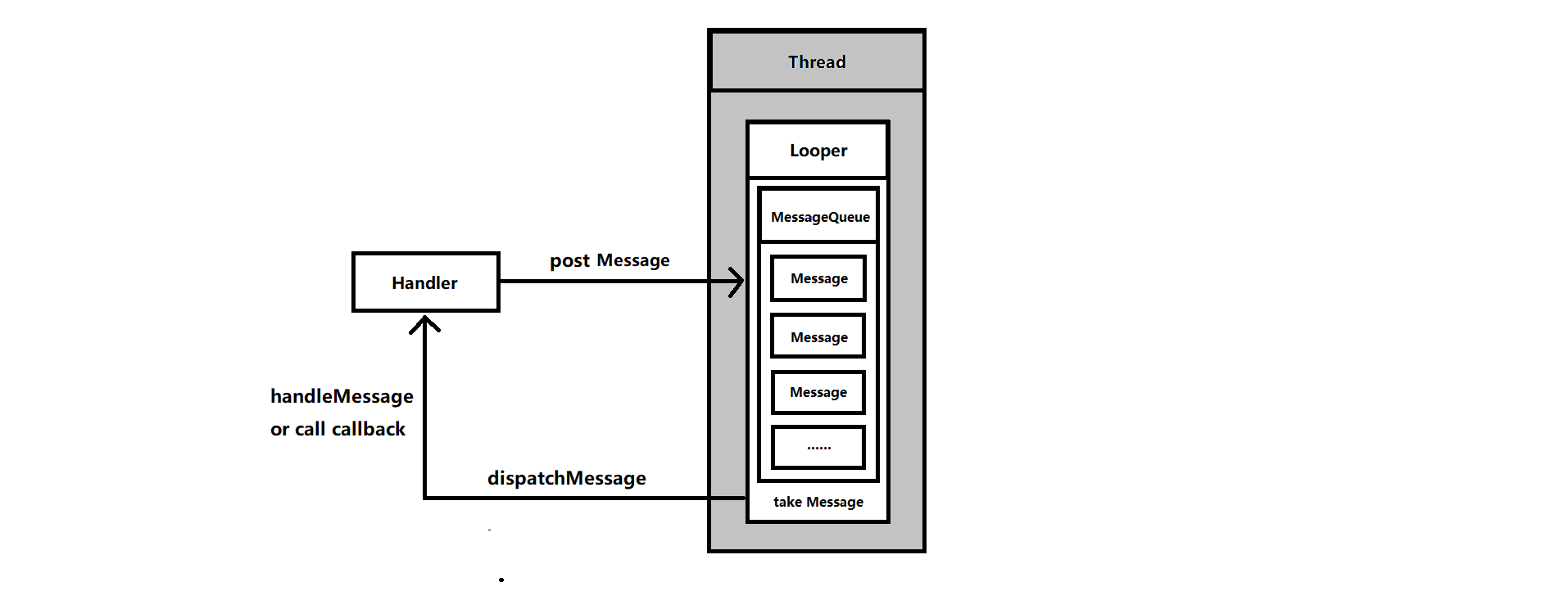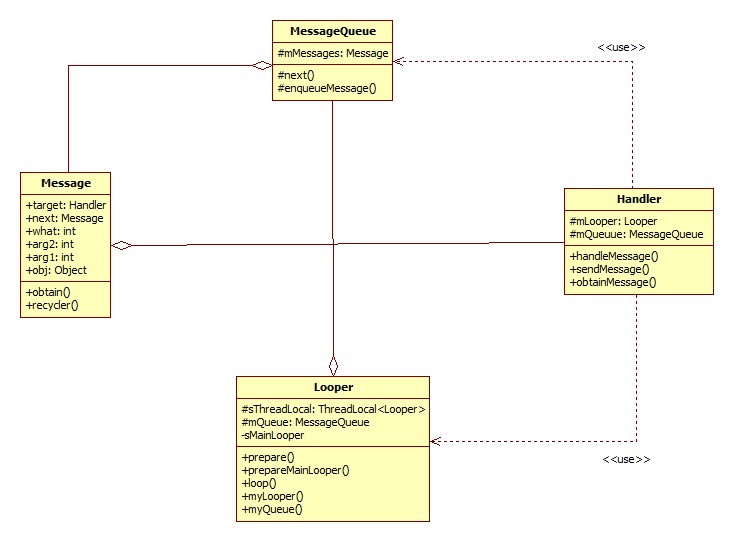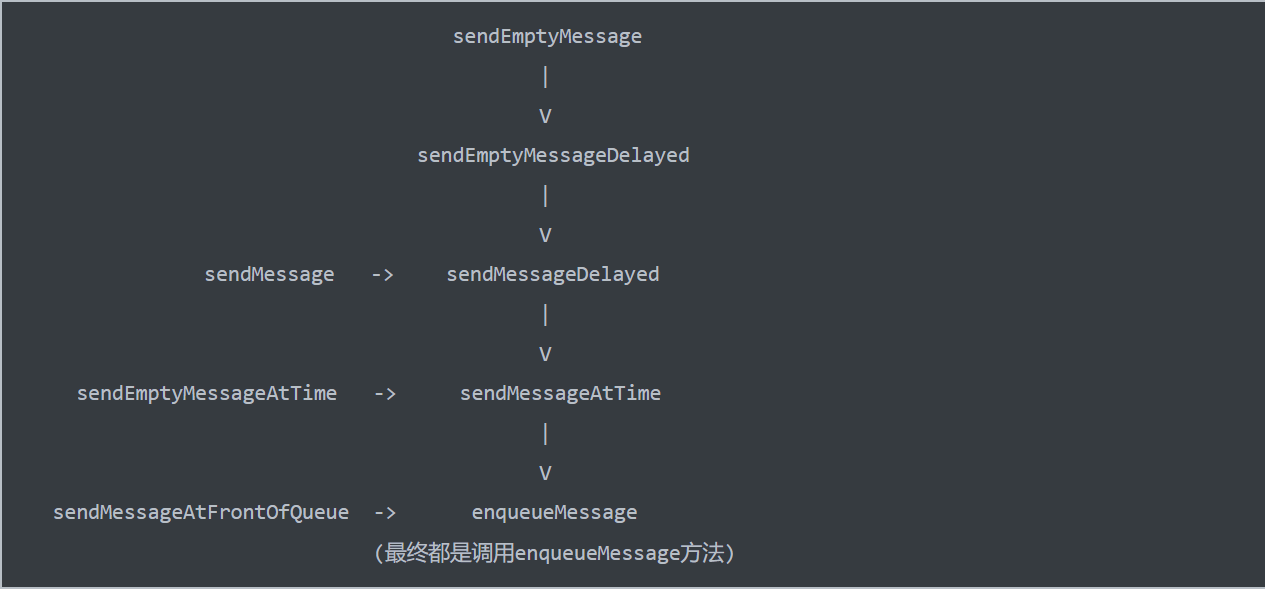前言
Android的消息机制用于同进程的线程间通信,它是由MessageQueue,Message,Looper,Handler共同组成,Android中大量的交互都是通过消息机制,比如四大组件启动过程与服务的交互、View的绘制、更新等都离不开消息机制,所以Android在某种意义上也可以说成是一个以消息驱动的系统,在Android中消息机制的运作分为java层和native层,它们之间的运作机制不一样,本文讲解的是java层的消息机制,如果你想了解native层的消息机制,可以阅读:
但其实java层的消息机制的核心功能都交给了native层的消息机制来完成,但作为应用开发,首先要掌握java层的消息机制。
本文源码基于Android8.0,源码相关位置:
frameworks/base/core/java/android/os/.java (\代表MessageQueue、Handler、Looper、Message)
消息机制概述
Android应用的每个事件都会转化为一个系统消息即Message,消息中包含了事件的相关信息和消息的处理人即Handler,消息要通过Handler发送,最终被投递到一个消息队列中即MessageQueue,它维护了一个待处理的消息列表,然后通过Looper开启了一个消息循环不断地从这个队列中取出消息,当从消息队列取出一个消息后,Looper根据消息的处理人(target)将此消息分发给相应的Handle处理,整个过程如下图所示。

它们的工作原理就像工厂的生产线,Looper是发动机,MessageQueue是传送带,Handler是工人,Message则是待处理的产品。
java层消息机制架构图

- Looper — 是每个线程的MessageQueue管家,里面有一个MessageQueue消息队列,负责把消息从MessageQueue中取出并把消息传递到Handler中去,每个线程只有一个Looper;
- MessageQueue — 消息队列,有一组待处理的Message,主要用于存放所有通过Handler发送的消息,每个线程只有一个MessageQueue;
- Message — 是线程之间传递的消息,里面有一个用于处理消息的Handler;
- Handler — 主要用于发送和处理消息,里面有Looper和MessageQueue。
简单使用
在开发中,我们在子线程中执行完操作后通常需要更新UI,但我们都知道不能在子线程中更新UI,此时我们就要通过Handler将一个消息post到UI线程中,然后再在Handler中的handleMessage方法中进行处理,如果我们不传递UI线程所属的Looper去创建Handler,那么该Handler必须在主线程中创建,如下:
1 | //在主线程中创建Handler |
以上就是我们平时使用Handler的常规用法了。
接下来我们以应用主线程(又叫做UI线程)的消息机制运作为例讲解Android消息机制的原理。
源码分析
1、 Looper的创建
我们知道Android应用程序的入口实际上是ActivityThread.main方法,而应用的消息循环也是在这个方法中创建,具体源码如下:
1 | //ActivityThread.java |
我们关注注释1,ActivityThread调用了Looper的prepareMainLooper方法来创建Looper实例,Looper的prepareMainLooper方法如下:
1 | //Looper.java |
线程在调用prepareMainLooper方法后,就代表它成为了一个UI线程,可以看到prepareMainLooper方法中是调用Looper的prepare方法来创建Looper实例,当要获取创建的Looper实例时,是通过Looper的myLooper方法来获取的,在调用prepare方法时,会把创建的Looper实例set到ThreadLocal中,当获取时也会从ThreadLocal中通过get方法获取,那么ThreadLocal是什么?这里简单介绍一下ThreadLocal:
ThreadLocal:线程本地存储区(Thread Local Storage,简称为TLS),每 个线程都有自己的私有的本地存储区域,不同线程之间彼此不能访问对方的TLS区域。
它的常用操作方法有:
ThreadLocal.set(T value):将value存储到当前线程的TLS区域。
ThreadLocal.get():获取当前线程TLS区域的数据关于ThreadLocal更多信息可以查看ThreadLocal原理解析.
ThreadLocal的get()和set()方法操作的类型都是泛型,我们从ThreadLocal在Looper中的定义可以看出,sThreadLocal的get()和set()操作的类型都是Looper类型, 所以,由于ThreadLocal的作用,每个线程只能保存一个Looper,不同线程的Looper是不相同的,这样,通过调用Looper.prepare(false)方法,UI线程中就保存了它对应的、唯一的Looper实例,当在UI线程调用Looper.myLooper方法时它就会返回UI线程关联的Looper实例,当然,如果你在子线程中想要获得UI线程关联的Looper实例,就需要调用getMainLooper方法,该方法如下:
1 | public static Looper getMainLooper() { |
以上就是UI线程的Looper的创建过程,执行ActivityThread.main后,应用程序就启动了,UI的消息循环也在Looper.loop方法中启动,此后Looper会一直从消息队列中取出消息,用户或系统通过Handler不断往消息队列中添加消息,这些消息不断的被取出,处理,回收,使得应用运转起来。
我们在平时开发时,一般是使用不带参数的prepare()方法来创建子线程对应的Looper实例,如下:
1 | //我们平时使用的prepare方法 |
和UI线程的区别是,UI线程的Looper是不允许推出的,而我们的Looper一般是允许退出的。
2、MessageQueue的创建
我们在上面知道,调用Looper的prepare方法就会创建Looper实例,同时会把Looper实例通过ThreadLocal保存到线程中,在创建Looper时还会同时在构造中创建MessageQueue实例,如下:
1 | //Looper.java |
Looper只有这一个构造函数,并且它是私有的,所以我们只能通过Looper的prepare方法创建Looper实例,由于ThreadLocal,每个线程最多只能对应一个Looper实例,而每个Looper内部只有一个MessageQueue实例,推出:每个线程最多对应一个MessageQueue实例。
我们看一下MessageQueue的构造,如下:
1 | //MessageQueue.java |
MessageQueue的构造中会通过native方法在native层创建一个属于native层的消息队列NativeMessageQueue,然后把NativeMessageQueue的地址返回给java层保存在mPtr中,java层和native层之间的通信就通过这个mPtr指针。
MessageQueue是消息机制的核心类,它是java层和native层的连接纽带,它里面有大量的native方法,Android有俩套消息机制(java层和native层,实现不一样),但本文只讲解java层的消息机制,不会涉及到native层.
关于native层的查看Android消息机制(native层)
我们通过Looper的myQueue方法就能获取到它关联的MessageQueue实例,如下:
1 | //Looper.java |
3、消息循环的运行
在ActivityThread的mian方法在创建Looper后,通过Looper.loop方法就启动了消息循环,这个函数会不断的从MessageQueue中取出消息、处理消息,我们点进此方法看一下它的源码:
1 | //Looper.java |
loop()中是一个死循环,我们关注注释1,loop()会调用MessageQueue的next()来获取最新的消息,当没有消息时,next()会一直阻塞在那里,这也导致loop()阻塞,唯一跳出循环的条件是next()返回null,这时代表Looper的quit()或quitSafely()被调用,从而调用MessageQueue的quit()来通知消息队列退出,如下:
1 | //Looper.java |
所以MessageQueue的next()是最关键的函数,我们来看看next函数的关键代码:
1 | //MessageQueue.java |
MessageQueue的next方法有点长,但是它里面的逻辑是很好理解的,它主要是通过一个死循环不断的返回Message给Looper处理,next方法可以分为两部分阅读:
1、获取java层的消息处理:
我们看Part1,先执行nativePollOnce方法,它是一个阻塞操作,其中nextPollTimeoutMillis代表下一次等待的超时时长,当nextPollTimeoutMillis = 0时或到达nextPollTimeoutMillis时,它会立即返回;当nextPollTimeoutMillis = -1时,表示MessageQueue中没有消息,会一直等待下去,直到Hanlder往消息队列投递消息,执行nativeWake方法后,MessageQueue被唤醒,nativePollOnce就会返回,但它此时并不是立即返回,它会先处理完native层的消息后,再返回,然后获取java层的消息处理;
接着next方法就会从mMessages链表的表头中获取一个消息,首先判断它是否是同步屏障,同步屏障就是target为null的Message,如果遇到同步屏障,MessageQueue就会优先获取异步消息处理,异步消息就是优先级比同步消息高的消息,我们平时发送的就是同步消息,通过Message的setAsynchronous(true)可以把同步消息变成异步消息,不管是同步还是异步,都是Message,获取到Message后;
接着判断Message是否到达它的执行时间(if(now == msg.when)),如果到达了执行时间,next方法就会返回这条消息给Looper处理,并将其从单链表中删除;如果还没有到达执行时间,就设置nextPollTimeoutMillis为下一次等待超时时长,等待下次再次取出判断,可以发现虽然MessageQueue叫消息队列,但它却不是用队列实现的,而是用链表实现的。
通过MessageQueue的postSyncBarrier方法可以添加一个同步屏障,通过removeSyncBarrier方法可以移除相应的同步屏障,在Android,Choreographer机制中就使用到了异步消息,在View树绘制之前,会先往UI线程的MessageQueue添加一个同步屏障,拦截同步消息,然后发送一个异步消息,等待VSYN信号到来,触发View树绘制,这样就可以让绘制任务优先执行。
2、没有消息处理,遍历IdleHandler列表,执行IdleHandler的queueIdle方法:
IdleHandler是什么?IdleHandler是一个接口,它里面只有一个queueIdle方法,Idle是空闲的意思,在MessageQueue空闲的时候会执行IdleHandler的queueIdle方法,我们可以通过MessageQueue的addIdleHandler方法添加我们自定义的IdleHandler到mIdleHandlers列表中,如下:
1 | //MessageQueue.java |
MessageQueue空闲,就代表它处于以下两种情况:
(1) mMessages == null,消息队列中没有消息处理;
(2) now < msg.when,有消息处理,但是还没有到消息的执行时间.
以上两种情况之一都会触发next方法遍历IdleHandler列表,执行IdleHandler的queueIdle方法的操作。
在Android中,我们平时所说的线程空闲其实就是指线程的MessageQueue空闲,这时就可以执行我们添加的IdleHandler,例如在LeakCanary中,它通过添加IdleHandler,在UI线程空闲时执行内存泄漏的判断逻辑.
4、消息的发送
到这里UI线程已经启动了消息循环,那么消息从何而来?消息是由系统产生,然后通过Hanlder发送到MessageQueue中,Handler就是用来处理和发送消息的,应用程序的Handler在ActivityThread中被创建,如下:
1 | //ActivityThread.java |
mH就是应用程序内部使用的Handler,我们外部是不可使用的,应用程序通过Handler往MessageQueue中投递消息,并通过Handler的handlerMessage方法处理消息,而我们在外部也可以使用自己创建的Handler往UI线程的MessageQueue投递消息。
既然Handle可以往MessageQueue中投递消息,这说明Handler要和相应的MessageQueue关联,我们看Handler的构造函数,Handler有两种构造函数:
一种是指定Callback的构造函数,Callback默认为null,如下:
1 | //Handler.java |
在构造中如果通过Looper.myLooper方法获取不到Looper,就会抛出“Can’t create handler inside threadxx that has not called Looper.prepare()”异常,所以如果我们在子线程中使用Handler的默认构造,没有先调用Looper.prepare方法就创建Handler的话,就会抛出上述异常,但是在UI线程中就不会,因为应用程序启动时就已经调用了Looper的prepareMainLooper方法,在该方法里面已经调用了prepare(false)方法创建了UI线程的Looper实例,无需我们再次调用Looper.prepare方法。
另外一种是指定Looper的构造函数(如果不指定,Looper默认从当前线程的TLS区域获取),如下:
1 | //Handler.java |
不管哪一种构造函数,可以看到,在Handler的最终构造中都会和对应线程的Looper、MessageQueue关联,所以就算Hander在子线程创建,我们也可以通过: Handler = new Handler(Looper.getMainLooper);把Handler关联上UI线程的Looper,并通过Looper关联上UI线程的MessageQueue,这样,就能把Handler运行在UI线程中。
消息的发送可以通过handler的一系列post方法和一系列的send方法,一系列post方法最终通过一系列send方法来实现,一系列send方法最终通过enqueueMessage方法来发送消息,如下:

可以发现Handler所有发送消息的方法,最终都是调用Handler的enqueueMessag方法,该方法源码如下:
1 | //Handler.java |
在该方法中,首先把Message的target字段设置为当前发送消息的Handler, 然后设置Message是否是异步消息,最后把所有逻辑交给MessageQueue的enqueueMessage方法,该方法的相应源码如下:
1 | //MessageQueue.java |
MessageQueue的enqueueMessage方法主要是一个链表的插入操作,返回true就代表插入成功,返回false就代表插入失败,它主要分为以下3种情况:
1、插入链表头部:
mMessages是按照Message触发时间的先后顺序排列的,越早触发的排得越前,头部的消息是将要最早触发的消息,当有消息需要加入mMessages时,如果mMessages为空或这个消息是最早触发的,就会直接插入链表头部;
2、插入链表的中间位置:
如果消息链表不为空并且插入的消息不是最早触发的,就会从链表头部开始遍历,直到找到消息应该插入的合适位置,以保证所有消息的时间顺序,这一个过程可以理解为插入排序;
3、判断是否调用nativeWake方法
最后,根据needWake是否为true,来决定是否调用nativeWake方法唤醒当前线程的MessageQueue,needWake默认为false,即不需要唤醒,needWake为true就代表此时处于以下2种情况:
(1)如果插入消息在链表头部并且mBlocked == true,表示此时nativePollOnce方法进入阻塞状态,等待被唤醒返回;
(2)如果插入消息在链表中间,消息链表的头部是一个同步屏障,同时插入的消息是链表中最早的异步消息,需要唤醒,即时处理异步消息。
5、消息的分发
在消息循环的运行中,如果loop方法中MessageQueue的next方法返回了Message,那么就会执行到这一句:*msg.target.dispatchMessage(msg)
*;Looper会把这条消息交给该Message的target(Handler对象)来处理, 实际上是转了一圈,Handler把消息发送给MessageQueue,Looper又把这个消息给Handler处理,下面来看消息分发逻辑,dispatchMessage()源码如下:
1 | //Handler.java |
里面代码量很少,分为3步:
1、检查msg.callback是否为空,不为空则执行” handleCallback(msg)”, 源码如下:
1 | //Handler.java |
msg.callback其实是一个Runnable对象,当我们通过Handler来post一个Runnable消息时,它就不为空,如下:
1 | //Handler.java |
可以看到,在post(Runnable r)中,会把Runnable包装成Message对象,并把Runnable设置给Message的callback字段,然后发送此消息。
2、如果msg.callback为空,检查mCallback是否为空,mCallback是一个Callback接口,定义如下:
1 | //Handler.java |
当我们这样:Handler handler = new Handler(callback) 来创建Handler时, mCallback就不为空,它的意义是当我们不想派生Handler的子类重写handleMessage()来处理消息时,就可以通过Callback来实现。
3、如果mCallback为空,最后调用Handler的handleMessage方法来处理消息,这就是我们平时熟悉的处理消息的方法。
从1、2、3可以看出,在Handler中,处理消息的回调的优先级为:Message的Callback > Handler的Callback > Handler的handleMessage方法。
6、消息的回收复用
1、消息的复用
前面多次提到了Message,当我们通过Handler的obtainMessage()或Message的obtain()获取一个Message对象时,系统并不是每次都new一个出来,而是先从消息池中(sPool)尝试获取一个Message。Handler的obtainMessage()最终是调用了Message的obtain(),Message的obtain方法如下:
1 | //Message.java |
sPool的数据类型为Message,通过next成员变量,维护一个消息池,消息池的默认大小为50。定义如下:
1 | public final class Message implements Parcelable { |
虽然叫消息池,其实是通过链表实现的,每个Message都有一个同类型的next字段,这个next就是指向下一个可用的Message,最后一个可用的Message的next为空,这样所有可用的Message对象就通过next串成一个Message池,sPool指向池中的第一个Message,复用消息其实是从链表的头部获取一个Message返回。
2、消息的回收
我们发现在obtain方法中新创建Message对象时,并不会直接把它放到池中再返回,那么Message对象是什么时候被放进消息池中的呢?是在回收Message时把它放入池中,Message中也有类似Bitmap那样的recycler函数,如下:
1 | //Message.java |
recycler函数先判断该Message是否还在使用,如果还在使用,就会抛异常,否则就调用recyclerUnchecked函数根据MAX_POOL_SIZE判断是否把该消息回收,回收前还要先清空该消息的各个字段,回收消息就是把自身插入到链表的表头。
通过消息的复用回收,减少Message对象不断创建与销毁的过程,提升了效率。
7、小结
1、创建Looper时,只能通过Looper的prepare方法创建,在创建Looper时会在内部创建一个MessageQueue,并把Looper保存在线程的TLS区域中,一个线程只能对应一个Looper,一个Looper只能对应一个MessageQueue;
2、在创建MessageQueue时,MessageQueue与NativeMessageQueue建立连接,NativeMessageQueue存储地址存于MessageQueue的mPtr字段中,java层和native通过mPtr字段进行通信(native端通过Linux的epoll机制建立起消息机制);
3、由于ThreadLocal的作用,Looper属于某个线程,而MessageQueue存储在Looper中,所以MessageQueue则通过Looper与特定的线程关联上,而Handler在构造中又与Looper和MessageQueue相关联,当我们通过Handler发送消息时,消息就会被插入到Handler关联的MessageQueue中,而Looper会不断的轮询消息,从MessageQueue中取出消息给相应的Handler处理,所以最终通过Handler发送的消息就会被执行到Looper所在线程上,这就是Handler线程切换的原理,无论发送消息的Handler对象处于什么线程,最终处理消息的都是Looper所在线程;
4、Looper从MessageQueue中取出消息后,会交给消息的target(Handler)处理,在Handler中,处理消息的回调的优先级为:Message的Callback > Handler的Callback > Handler的handleMessage方法;
5、因为应用程序启动时在ActivityThread.main方法中的Looper.prepareMainLooper()中已经调用了Looper.prepare(false),所以在主线程中创建Handler无需我们手动调用Looper.prepare(),而在子线程中,如果我们不传递UI线程所属的Looper去创建Handler,那么就需要调用Looper.prepare()后再创建Handle来传递消息,因为Handler要和某个线程中的MessageQueue和Looper关联,只有调用Looper.prepare方法,Looper和MessageQueue才属于某个线程;
6、消息池是一个单链表,复用Message时,从头出取出,如果取不到,则新建返回,回收Message时,也从头插入。
结语
本文从Android应用UI线程消息循环的创建,消息循环的启动,Handler与Looper、MessageQueue的关联,消息的发送与分发,还有消息的复用这几个角度来讲解了Message,Handler,MessageQueue,Looper之间是如何配合工作,在你了解java层的消息机制是如何运作后,希望大家去了解一下native的消息机制,例如要想知道为什么loop方法是死循环但却不会消耗性能,这些只有native层的消息机制才能给你答案.
除此之外,我们还知道了MessageQueue的IdleHandler的作用,它会在线程空闲时工作,还有异步消息的处理,它的优先级高于同步消息,会被优先处理,还有它们的应用场景,一般我们是在子线程切换到UI线程时使用Handler机制,但其实我们也可以在子线程使用Handler机制,可以参考Android中的HandlerThread,它的底层就是Handler+Thread.
以上就是本文的全部内容,希望大家有所收获。
参考资料:
